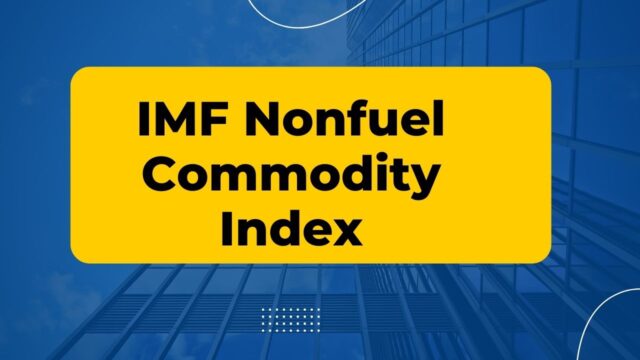
What is the IMF Nonfuel Commodity Index
The Index is a weighted average of a broad basket of nonfuel commodities. The index was first published in July 1964 and has been calculated monthly since January 1971. The inclusion of certain commodities in the index, and their weights, are reviewed periodically to ensure that the index reflects changing patterns in global commodity production and trade.
The IMF Nonfuel Commodity Index currently consists of 24 commodities: aluminum, coffee, copper, corn, cotton, sugar, lead, logs and lumber, maize (corn), natural gas, nickel, oil (Brent crude), pigs and pork, platinum group metals (iridium, osmium, palladium, platinum, rhodium), poultry, rapeseed oil meal or cake , rubber (natural latex), silver, soybean oil meal or cake , soybeans , tin , and wheat. Wool is no longer included in the index as of December 2017.
How is the IMF Nonfuel Commodity Index calculated
The IMF Nonfuel Commodity Index is a measure of the world prices of nonfuel commodities. It is compiled by the International Monetary Fund (IMF) and consists of a basket of 21 commodities weighted according to the average export shares of each commodity over a 5-year period. The index was first published in 1999 and is updated monthly. In order to be included in the index, a commodity must be produced internationally, traded on international markets, and have an internationally recognized price. The weights of the individual commodities in the index are reviewed every 5 years. The index is used as a measure of global commodity prices and as a predictor of inflation. It is also used by central banks and other financial institutions to assess the riskiness of investments in commodity-producing countries.
Which commodities are included in the IMF Nonfuel Commodity Index
The IMF Nonfuel Commodity Index is a broad measure of commodity market performance. It includes eighteen commodities, grouped into four categories: energy, metals, minerals, and agricultural products. The index is compiled monthly and released in the middle of the following month. The energy category includes crude oil, natural gas, and heating oil; the metals category includes aluminum, copper, lead, nickel, tin, and zinc; the minerals category includes gold and silver; and the agricultural category includes coffee, cotton, maize, sugar, wheat, and soybeans. This index provides a valuable snapshot of global commodity market conditions and is widely used by economists and financial analysts.
What are some of the implications of the IMF Nonfuel Commodity Index
The index tracks a basket of nonfuel commodities, including metals, agricultural products, and energy. While the index is widely used by investors and analysts, there are a few key implications that should be considered when interpreting the data. First, the index is highly volatile, which can make it difficult to predict short-term movements in prices. Second, the index is heavily influenced by global economic conditions, which means that it can be a useful indicator of broader economic trends. Finally, the index is subject to seasonal effects, so it is important to account for these when analyzing the data. Overall, the IMF Nonfuel Commodity Index is a valuable tool for understanding trends in the commodities markets, but it is important to consider its limitations when interpreting the data.
What are some of the criticisms of the IMF Nonfuel Commodity Index
The index has been criticized for its methodology and for its potential to distort markets. One criticism is that the index weightings are based on production levels, rather than consumption. This means that commodities with high production levels, such as gold and copper, have a greater impact on the index than commodities with low production levels but high consumption, such as coffee and cocoa. As a result, the index may not accurately reflect actual market conditions. Another criticism is that the index only includes non-fuel commodities, meaning that it excludes energy commodities such as crude oil and natural gas. This exclusion means that the index may not provide an accurate picture of global commodity prices. Finally, some have argued that the presence of the IMF Nonfuel Commodity Index in markets can lead to price bubbles and distorted incentives for producers. For example, if the price of coffee rises sharply due to an increase in demand from China, this may encourage Brazilian farmers to switch to coffee production, leading to an oversupply in global markets and a collapse in prices.
How can investors use the IMF Nonfuel Commodity Index
The IMF Nonfuel Commodity Index can be used by investors to gain exposure to the broad nonfuel commodity market. The index includes 19 commodities, ranging from agricultural products to metals and minerals. By investing in the index, investors can diversify their portfolios and hedge against inflation. Additionally, the index can be used as a tool to track global economic growth. For example, a rise in the index may indicate that demand for commodities is increasing, while a decline may signal slowing economic growth. As such, the IMF Nonfuel Commodity Index can provide valuable insights for investors seeking to profit from changes in the commodity markets.


































